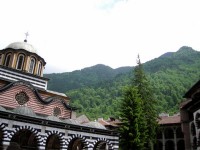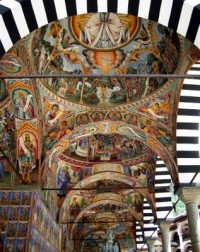Spring is a wonderful time to see Rila Monastery, a UNESCO Heritage site and a place that not only tops any must-see list in the Balkans but is held dearly in the Bulgarian national consciousness. It was built by an order led by Ivan Rilski, a 10th-century hermit, and became a sanctuary for Bulgarian culture through 500 years of Ottoman rule that lasted until the late 19th century.  After having lived in Bulgaria for two years and somehow missing every opportunity to visit the monastery with friends, I finally decided to just get on a bus and go down to see it myself. (I paired the visit with a narrow-gauge rail journey through the Rila and Rhodope Mountains, which made for an altogether excellent weekend.)
After having lived in Bulgaria for two years and somehow missing every opportunity to visit the monastery with friends, I finally decided to just get on a bus and go down to see it myself. (I paired the visit with a narrow-gauge rail journey through the Rila and Rhodope Mountains, which made for an altogether excellent weekend.)
The Rila Monastery is beautiful, 20 kilometers from the nearest town, and well worth more time than I had to see it. I was there for only a few hours, but plentiful hiking trails around the area and the ability to stay overnight in former monks’ cells could easily keep one occupied for a whole weekend. Embraced by the mountain that supports it, the Rila Monastery is almost fortress-like upon approach; everything is housed in a circular building that surrounds and protects the church, which sits in the central courtyard.  The walls of the church are saturated with eye-popping frescoes inside and out, and even walking through one of the arcades, it’s easy to feel surrounded and cared for by the stories and spirit of the artists’ work. Particular to Bulgarian sacred architecture are black-and-white striped arches, which you can see adorning many spaces.
The walls of the church are saturated with eye-popping frescoes inside and out, and even walking through one of the arcades, it’s easy to feel surrounded and cared for by the stories and spirit of the artists’ work. Particular to Bulgarian sacred architecture are black-and-white striped arches, which you can see adorning many spaces.
There are a few souvenir stalls around, but the line is constant at the bakery, where you can buy fresh bread and sheep’s milk yogurt, a local specialty. The yogurt is really tasty – it has more of a bite than cow or goat yogurt, but it’s not overwhelming, and everyone milling around had a little container of the stuff that they were nursing. Any trip to Bulgaria will involve yogurt, I promise: one of the active cultures involved in yogurt-making is Lactobacillus bulgaricus, and Bulgarians are very proud to have this recognition. If you go to the shop and ask for milk, the shopkeeper will ask if you want pryasno (fresh) or kiselo (sour); this means, do you want regular milk, or do you want yogurt? It goes in everything, from soups to sauces, and most often it’s made from cow’s milk, but a long tradition of sheep farming in the southwest means that in this region, you’ll get the slightly smoky, full texture of sheep’s milk products. (It goes wonderfully with cherries and mint, both growing in abundance in June.)
 I left Bulgaria not long after my trip to Rila, and it is with regret that I had not gone earlier so that I could find the excuse to go back and spend more time. Go! And let the spirit of sacred art breathe over your shoulders, while drinking in the mountains carpeted in forest.
I left Bulgaria not long after my trip to Rila, and it is with regret that I had not gone earlier so that I could find the excuse to go back and spend more time. Go! And let the spirit of sacred art breathe over your shoulders, while drinking in the mountains carpeted in forest.


Comments